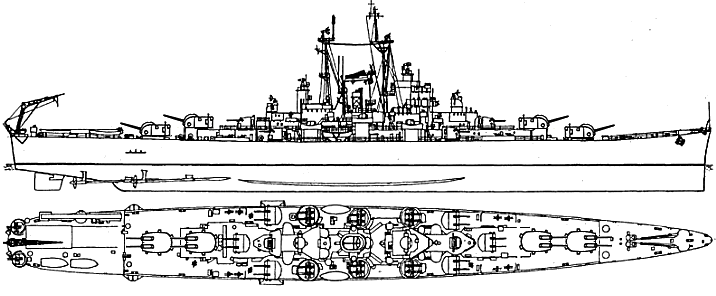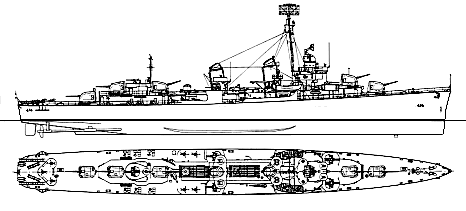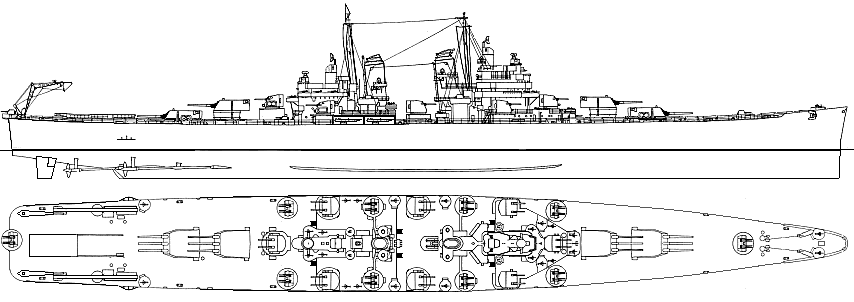
Los Angeles and Wichita will complete in 1942. Others will follow, probably in 1941 & 42.
Los Angeles, United States Heavy Cruiser laid down 1940
Displacement:
22,759 t light; 23,702 t standard; 25,712 t normal; 27,321 t full load
Dimensions: Length overall / water x beam x draught
766.15 ft / 757.00 ft x 85.00 ft x 27.00 ft (normal load)
233.52 m / 230.73 m x 25.91 m x 8.23 m
Armament:
12 - 8.00" / 203 mm guns (4x3 guns), 335.00lbs / 151.95kg shells, 1940 Model
Breech loading guns in turrets (on barbettes)
on centreline ends, evenly spread, 2 raised mounts - superfiring
12 - 5.00" / 127 mm guns (6x2 guns), 55.12lbs / 25.00kg shells, 1940 Model
Dual purpose guns in deck mounts with hoists
on side, all amidships, all raised mounts - superfiring
4 - 5.00" / 127 mm guns (2x2 guns), 55.12lbs / 25.00kg shells, 1940 Model
Dual purpose guns in deck mounts with hoists
on centreline ends, evenly spread, all raised mounts
40 - 1.10" / 27.9 mm guns (10x4 guns), 0.67lbs / 0.30kg shells, 1940 Model
Anti-aircraft guns in deck mounts
on side, evenly spread, 4 raised mounts
52 - 0.50" / 12.7 mm guns (26x2 guns), 0.06lbs / 0.03kg shells, 1940 Model
Anti-aircraft guns in deck mounts
on side, evenly spread, 18 raised mounts
Weight of broadside 4,932 lbs / 2,237 kg
Shells per gun, main battery: 150
12 - 21.0" / 533.4 mm above water torpedoes
Armour:
- Belts: Width (max) Length (avg) Height (avg)
Main: 8.00" / 203 mm 492.05 ft / 149.98 m 11.06 ft / 3.37 m
Ends: Unarmoured
Main Belt covers 100 % of normal length
- Gun armour: Face (max) Other gunhouse (avg) Barbette/hoist (max)
Main: 8.00" / 203 mm 3.00" / 76 mm 8.00" / 203 mm
2nd: 2.00" / 51 mm 1.00" / 25 mm 2.00" / 51 mm
3rd: 2.00" / 51 mm 2.00" / 51 mm 2.00" / 51 mm
- Armour deck: 5.00" / 127 mm, Conning tower: 8.00" / 203 mm
Machinery:
Oil fired boilers, steam turbines,
Geared drive, 4 shafts, 173,559 shp / 129,475 Kw = 35.00 kts
Range 10,000nm at 15.00 kts
Bunker at max displacement = 3,619 tons
Complement:
1,014 - 1,319
Cost:
£11.262 million / $45.047 million
Distribution of weights at normal displacement:
Armament: 513 tons, 2.0 %
Armour: 7,403 tons, 28.8 %
- Belts: 1,832 tons, 7.1 %
- Torpedo bulkhead: 0 tons, 0.0 %
- Armament: 1,226 tons, 4.8 %
- Armour Deck: 4,194 tons, 16.3 %
- Conning Tower: 150 tons, 0.6 %
Machinery: 4,641 tons, 18.0 %
Hull, fittings & equipment: 9,903 tons, 38.5 %
Fuel, ammunition & stores: 2,953 tons, 11.5 %
Miscellaneous weights: 300 tons, 1.2 %
Overall survivability and seakeeping ability:
Survivability (Non-critical penetrating hits needed to sink ship):
40,009 lbs / 18,148 Kg = 156.3 x 8.0 " / 203 mm shells or 3.4 torpedoes
Stability (Unstable if below 1.00): 1.14
Metacentric height 5.0 ft / 1.5 m
Roll period: 15.9 seconds
Steadiness - As gun platform (Average = 50 %): 55 %
- Recoil effect (Restricted arc if above 1.00): 0.45
Seaboat quality (Average = 1.00): 1.11
Hull form characteristics:
Hull has a flush deck
and transom stern
Block coefficient: 0.518
Length to Beam Ratio: 8.91 : 1
'Natural speed' for length: 31.62 kts
Power going to wave formation at top speed: 57 %
Trim (Max stability = 0, Max steadiness = 100): 50
Bow angle (Positive = bow angles forward): 7.00 degrees
Stern overhang: 4.36 ft / 1.33 m
Freeboard (% = measuring location as a percentage of overall length):
- Stem: 39.00 ft / 11.89 m
- Forecastle (18 %): 26.00 ft / 7.92 m
- Mid (50 %): 24.00 ft / 7.32 m
- Quarterdeck (18 %): 24.00 ft / 7.32 m
- Stern: 27.00 ft / 8.23 m
- Average freeboard: 25.85 ft / 7.88 m
Ship space, strength and comments:
Space - Hull below water (magazines/engines, low = better): 76.3 %
- Above water (accommodation/working, high = better): 181.9 %
Waterplane Area: 45,344 Square feet or 4,213 Square metres
Displacement factor (Displacement / loading): 122 %
Structure weight / hull surface area: 145 lbs/sq ft or 710 Kg/sq metre
Hull strength (Relative):
- Cross-sectional: 0.96
- Longitudinal: 1.40
- Overall: 1.00
Hull space for machinery, storage, compartmentation is excellent
Room for accommodation and workspaces is excellent

Quoted
Originally posted by CanisD


Quoted
Originally posted by klagldsfQuoted


